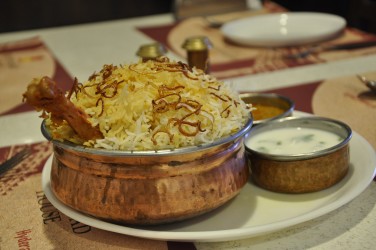by Jenny Sulfath
As I was growing up, whenever my mother – Sulu as I call her – felt too lazy to cook we would go out and eat biryani. Years have passed, and I now know cooking, but even today, when we go out with Sulu we only order biryani. The three of us, Sulu, father and I browse through the menu each time, but we always, always order biryani; such is the connection between my mother and chicken.
It is a common myth in Kerala that women born in a Muslim family learn the recipe of biryani by birth. As for Sulu, the only thing she inherited by birth was the taste for chicken which she passed on to me. When I was young I would frequently ask her how she wanted to die, and she would say ‘eating 5 kg of fried chicken’ and each time she said that, I would laugh, imagining my mother with chicken on a hospital bed.
So coming back to the recipe; no, my mother didn’t know the recipe of biryani by birth. She learnt it with her Hindu sister-in-laws who invited our Muslim neighbour to teach us how to make biryani. The neighbour told us that she had a biryani paatram, a pot that was designated specially for cooking biryani. However, given with us making biryani was an occasional affair, mother never bothered to buy it; instead, she would borrow grandmother’s copper uruli[1] which was used to make payasam[2], and both the dishes existed peacefully in the different households, travelling back and forth in the copper uruli on my bike. Amma used the copper uruli to make the rice and an aluminium one to prepare chicken and masala.
Making biryani involved all three of us. My duty was to chop the onions really thin, for thinner the onion, tastier the biryani. When I finished with the onions, tears in my eyes, I would quietly turn on the TV and sit in front of it, losing all my initial enthusiasm for cooking. My father, hovering around in the kitchen, would slowly leave too. Sulu, noticing this, would drop garlic on our laps, annoyed, as she couldn’t leave the mission just like us. Garlic too is very important for the masala – more the garlic, tastier the biryani. Peeling garlic needed a lot of patience, especially when a house had only two knives and both were in use at the same time. If father peeled the garlic, I’d cut. If I peeled, father would cut. Amma would fry the onion, then add the cut tomatoes and fry it with the ginger-garlic green chili paste that Appa made, and sprinkle garam masala over it. To this she’d add chicken boiled with salt and the biryani masala available in market.
Though cooking the masala is considered the most difficult, Sulu would panic when it came to making the ghee rice. The panic would usually begin after she fried the rice in ghee and poured water to it, and she would stir it, repeating all the while ‘I never get the water right!’ The final result was a long-drawn process: the chicken had to be mixed with the rice in layers: one layer of rice, then one layer of chicken, and so on. She would taste the raw rice every now and then and wonder whether it’s cooked or not. As we waited for the layers to get cooked, the three of us would find time to talk with each other patiently. The responsibility of making the lemon tea after the biryani was mine, and that was one art I learned perfectly.
Sulu liked biryanis because that was the only participatory meal cooked in the house. Her dosas, idlis and nool puttu[3] , on the other hand, were lonely, the mild cold tea I would gulp down before running to school tasted protest. Even now, when I go back home, Sulu decides to cook Biryani, perhaps because it’s the only democratic lunch.
These days, when on mornings I wake up alone and boil milk for the morning chai, I think of all the mornings when she had to wake up at 5 o’clock, make breakfast and lunch for all and pack it, wash the last night’s utensils, take out the forgotten clothes from the washing machine. That’s years of spilled milk, anxious idlis, overcooked lunch, panicked rasam[4].
[1]A traditional cookware extensively used in South India. It is commonly made of clay, copper or bronze.
[2] A South Indian variety of creamy puddings, made with vermicelli, rice or Bengal gram, coconut milk and sugar
[3] A breakfast dish made of roasted rice and salt in Kerala
[4] A soupy South Indian curry prepared with tamarind and tomato juice with added spices and garnish






